Temple Worship
The Vedic paradigm poses an enigma. God is everywhere. Within the hearts
of all. Within each atom. God is the greatest mystery, beyond the purview
of our senses. He, along with His countless devotees, is situated in
Viakunta, the spiritual realm, eternally engaged in pastimes of Love.
But The Supreme Lord makes Himself easily available by manifesting as the
arca-vigraha. 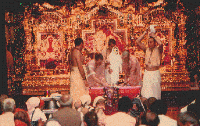
The arca-vigraha is the Deity form of the Lord found in the temple.
Anyone can come to see and serve the Lord; to offer prayers or bring a
gift. Visitors to New Vrindavan, walking into the temple, are
confronted by several alters: Radha Krishna,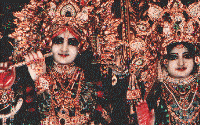 Sri Nataji, Gaura-
Nitai, Jaganatha, Nrsimhadev. People who are unfamiliar with
the Vaisnava/Hindu religion may mistakenly think that the devotees
worship many Gods. But the devotees explain that there is only one God
who has innumerable names, qualities, features, and activities. The
various alters in the temple reflect the variety of pastimes of the one
Supreme Lord.
Sri Nataji, Gaura-
Nitai, Jaganatha, Nrsimhadev. People who are unfamiliar with
the Vaisnava/Hindu religion may mistakenly think that the devotees
worship many Gods. But the devotees explain that there is only one God
who has innumerable names, qualities, features, and activities. The
various alters in the temple reflect the variety of pastimes of the one
Supreme Lord. 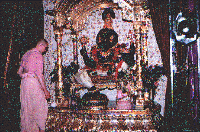 The ancient literatures of India (Puranas, Ramayana,
Mahabharata) describe these wondrous pastimes and incarnations of
God. Lord Krishna explains in the Bhagavad Gita that He appears in
various ages to protect the devotees, destroy the wicked, and to
reestablish the principles of religion when they appear to be lost.
The ancient literatures of India (Puranas, Ramayana,
Mahabharata) describe these wondrous pastimes and incarnations of
God. Lord Krishna explains in the Bhagavad Gita that He appears in
various ages to protect the devotees, destroy the wicked, and to
reestablish the principles of religion when they appear to be lost.
Mangala Arati: The temple bells ring, and ancient slokas (hymns) are
recited while offerings are made to the Deity during the auspicious
brahma muhurtha (the morning hours before sunrise). 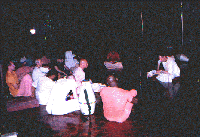 This scene unfolds in
countless temples throughout India . It has been this way for millennia.
This scene unfolds in
countless temples throughout India . It has been this way for millennia.
In the late 60's and early 70's, a handful of ISKCON temples including
New Vrindavan established the first elaborate Deity worship in the
West. Now across America, this event is occurring with more frequency
as many Hindu communities establish Mandirs (Temples) in their own areas
so that they may have dharsan (audience) of the Supreme Lord.
The devotees at New Vrindavan maintain the alters and keep a rigorous
daily Deity schedule, performing several services during various parts
of the day. They cleanse and decorate the alters. They prepare delicious
vegetarian foods to be offered. Each day they string numerous flower
garlands for the alters. They offer prayers and study scripture.
They sing Sanskrit hymns and dance before the Deity.
And those who live far away periodically travel on pilgrimage to see
the Deity and receive blessings.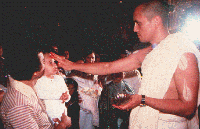
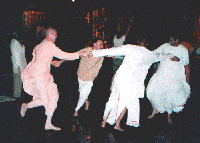
Schedule for Daily Morning Worship at the Radha Krishna Temple in New
Vrindavan
4:45 Mangala Arati - 1st service of the day accompanied by singing and
dancing.
5:30 Prayers and Watering of Tulasi plant. (Tulasi is a sacred plant
used in Deity
worship)
5:45 Japa Meditation - Devotees chant individually on their prayer
beads.
7:15 Greeting of the Deities.
7:30 Guru puja - offering prayers to Srila Prabhupada, the
Founder-Acarya of
ISKCON and the worldwide Hare Krishna Movement.
7:45 Class in Srimad Bhagavatam. (Bhagavat Purana)
8:45 Breakfast.
Additional Images
1
2
3
4
5
6
7
8

